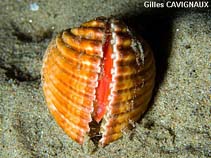Acanthocardia echinata (Linneaus, 1758)
European prickly cockle| Native range | All suitable habitat | Point map | Year 2050 |

|
| This map was computer-generated and has not yet been reviewed. |
| Acanthocardia echinata AquaMaps Data sources: GBIF OBIS |
Classification / Names आम नाम | उपशब्द | CoL | ITIS | WoRMS
Bivalvia | Cardiida | Cardiidae
Environment: milieu / climate zone / गहराई सीमा / distribution range पारिस्थितिकी
; गहराई सीमा 0 - 619 m (संदर्भ 105829). Subtropical; 83°N - 27°N, 127°W - 36°E
Distribution देश | ऐफ ऐ ओ क्षेत्र | Ecosystems | संयोग | भूमिका
Arctic, Eastern Atlantic and the Mediterranean Sea: from Canadian Arctic to Iceland, Norway, Sweden, south to Morocco, Madeira Island and Canary Islands, and the Mediterranean. Polar to subtropical.
Length at first maturity / आकार / Weight / Age
परिपक्व अवधि: Lm ? range ? - ? cm Max length : 7.5 cm SHL पुल्लिंग / अलिंग; (संदर्भ 128384)
Life cycle and mating behavior परिपक्व अवधि | पुनरुत्पत्ति | मछलीऔ का अंडे देना | Eggs | Fecundity | Larvae
Main reference
संदर्भ | संयोजक | सहयोगीयो
FAO 2007 Seafood in Europe. FAO Seafood in Europe CD's 4. (संदर्भ 78075)
IUCN Red List Status
(संदर्भ 130435: Version 2025-1)
CITES status (संदर्भ 108899)
CMS (संदर्भ 116361)
Threat to humans
Human uses
मात्स्यिकी: व्यापारिक
| FishSource |
साधन
अधिक जानकारी
इंटरनेट स्रोत
BHL | BOLD Systems | CISTI | DiscoverLife | FAO(Publication : search) | Fishipedia | GenBank (genome, nucleotide) | GloBI | Gomexsi | Google Books | Google Scholar | Google | PubMed | Tree of Life | Wikipedia (Go, खोज) | Zoological Record



